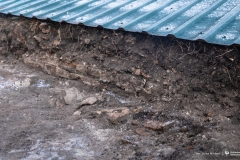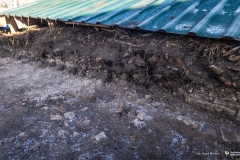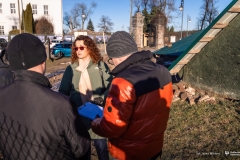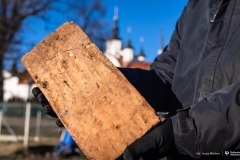Bialystok University of Technology is supporting the Suprasl Monastery in the campaign #ratujemykatakumby. Plans to strengthen the structure and stop the destruction
15-12-2024
In addition to the monks, Bialystok University of Technology, the University of Bialystok, Medical University of Bialystok, Christian Academy of Theology in Warsaw, Military University of Technology and the Nicholas Copernicus University in Torun have been involved in saving the catacombs, which are an integral part of the Suprasl Monastery.
– For Bialystok University of Technology, it is a challenge, but also participation in a very prestigious project – says Assoc. Prof. Marta Kosior-Kazberuk, DSc, PhD, Eng, Rector of Bialystok University of Technology. – Each university brings something, but each will also gain new knowledge.
The brick structure of the 16th-century catacombs was excavated from the ground in 2012-2013. The exposed front surfaces of the vaults crowning the burial niches were exposed to aggressive environmental factors for several consecutive years. In order to properly protect the historic substance against further degradation, it is necessary to carry out comprehensive research: archaeological, architectural, structural or pathomorphological.
– Works related to saving the catacombs are gaining momentum – informs the Rector of Bialystok University of Technology. – Employees of Bialystok University of Technology are starting strength tests, wall salinity tests, mycological tests, and we are also going to analyze the microstructure of old mortars and historical bricks very carefully. This is very important, first of all, for saving this object, for understanding how it was created and how it should therefore be protected, but it is also important from the point of view of the history of the development of building materials. This is a benefit, first of all, for the historical object, but also a very important exploratory act for our staff. I think it will result in interesting scientific publications.
Bialystok University of Technology has already completed part of its research.
– We began our assessment of the stage of deterioration with structural nondestructive testing, which allowed us to develop detailed documentation for permanent protection of the historic substance of the catacomb walls from further degradation, – explains Assoc. Prof. Janusz Krentowski, DSc, PhD, Eng , from the Department of Geotechnics and Structural Mechanics of the Faculty of Civil Engineering and Environmental Sciences of Bialystok University of Technology. – Employees and doctoral students of the Bialystok University of Technology formulated requirements for the means of ad hoc protection. They were necessary for the safe conduct of conservation works. Then we developed detailed design documentation of permanent protection.
In spring 2024 the Monastery of the Annunciation of the Blessed Virgin Mary in Suprasl obtained funding for preliminary works protecting the Suprasl catacombs against progressive degradation.
The funds has allowed to intensify research works, both in the archaeological, architectural and constructional aspects, and above all to strengthen the damaged structure and bring it to the stage of the so-called ‘permanent ruin’, i.e. to stop the processes of further destruction.
Archaeologists uncover the past just below the ground
To achieve such a state, specialized restoration work must be carried out, involving the introduction of chemicals into the damaged brick wall structures. The historic building, strengthened in this way, should eventually be covered with a steel structure, creating permanent protection against the harmful effects of weather and access by people and animals.
– My archaeological research is closely related to the works that secure the catacombs and my task is to prepare space or discover elements that are necessary to know in order to do the work – says Assoc. Prof. Maciej Karczewski, PhD, archaeologist. – At the moment, the excavations are being carried out outside the catacombs on the northwest side. We have managed to uncover the outer face of the wall, but we also have two additional very interesting discoveries. The first is an unknown or so far unrecorded in any way remnant of what is most likely a Gothic brick floor, that is probably some extension concurrent to catacombs, which simply deteriorated before it was recorded in the sources. We found an archaeological excavation from 40 years ago, which was known to have been there, but its exact location had been unknown. The excavation was covered by a large pile of rubble, but also communist-era trash, which had been excavated from inside the catacombs in the mid-1980s as part of the preparatory work for restoration, which unfortunately never took place. It ended only in archaeology, which is why the degradation of this unique building continued until today.
Bialystok University of Technology has already performed a whole series of analyses. They will be continued, because as the work also progresses archaeologically, it will be possible to record new facts related to the history of the construction or repair of the catacombs. In addition, it will be possible to collect additional samples for analysis of the materials from which the catacombs were built. In December 2024, the works carried out primarily serve to prepare the interior of the catacombs for the final protective measures.
– First of all, the roof was raised, which sheltered the catacombs in 2014 – informs Assoc. Prof. Maciej Karczewski, DSc, PhD – At that time it was rested on the walls of the catacombs, which prevented any work on the walls as long as they were affected by the pressure of the roof. As part of the inventory work in the catacombs, the assessment of the condition of the walls, it proved necessary to expand the scope of the previously planned work to include the restoration of part of the western wall which is the most damaged. Moreover, it is inclined towards the interior of the catacombs and it is simply necessary to build a solid foundation, and only on this foundation a part of the inner face of the western wall will be reconstructed in order to stabilize the entire structure.
Are archaeologists expecting any finds related to the burials in the catacombs?
– I would love to, although the chances are slim – admits Assoc. Prof. Maciej Karczewski, DSc, PhD. – Since the second half of the 20th century, the catacombs have been regularly plundered. It is worth remembering that the people buried there are not only monks from the monastery, but they are the entire elite of the Polish-Lithuanian Commonwealth with an emphasis on the Grand Duchy of Lithuania.
Unfortunately, most of the remains, which were in burial niches, were at different times removed from them, in whole or in part. Some niches still have incomplete skeletons, and a few niches have planks on which the bodies of the dead were placed inside. If we are lucky, we may also find objects next to these preserved remains. They will not be spectacular objects, they could be parts of clothing, they could be some personal objects of worship. First of all, probably crosses.
It’s not our concern to excavate these objects, because they will not go to the museum. It has been decided, and this is the best possible decision, that both the human remains and all objects found beside them will be treated as objects belonging to the deceased and will return together with their remains for burial. There will be no archaeological exhibition of objects discovered in the catacombs.
Structural and renovation work is currently underway to eliminate the state of emergency and protect the facility from progressing deterioration. The works will be completed in 2025.
– There is enough work to last for years, but it must be done by next autumn, as there is money to secure the catacombs. This will be the end of the most essential stage. After that, the catacombs can be adapted, reconstructed, and other activities can be carried out in order to give the catacombs the function that Andrzej Borkowski, PhD, Bishop of Suprasl proposed, that is, to maintain the sacred function while making part of this monument to history available to all interested parties.
In 2021, the rectors of four Polish universities: Bialystok University of Technology, the University of Bialystok, the Medical University of Bialystok and the Christian Theological Academy in Warsaw undertook the mission of saving the 16th-century Suprasl monastic catacombs. Its aim was to jointly conduct multidisciplinary scientific research and expertise to determine the state of preservation of catacombs, develop substantive assumptions for their restoration and conservation, and support future conservation activities carried out at this extraordinary monument, which in 2023 was granted the Historic Monument of the Republic of Poland status.
The years 2022-2023 were full of many important undertakings related to the scientific research of the current state of the catacombs and their surroundings. Extensive activities were undertaken: registration and design, as well as typological and comparative queries, in particular in the field of theology, archaeology, architecture, heritage protection and monument conservation, history, art history, anthropology, material engineering. These activities in the first stage consisted in conducting archaeological, architectural and conservation research and analysis, necessary to develop substantive assumptions for the conservation of catacombs as well as georadar and excavation research, which in the future will enable the determination of the boundaries of the burial cemetery around the catacombs. At the same time, intensive queries and analytical works of historians and architects were undertaken, aimed at recreating the history of the catacombs, with particular emphasis on the history of their construction, reconstruction and destruction after their cessation of use, as well as determining their original shape and identifying people buried in the catacombs.
At the end of 2023, Military University of Technology joined the group of universities in the campaign #ratujemykatakumby. Scientists from the Nicolaus Copernicus University in Torun are also taking part in the campaign.
by jd


































